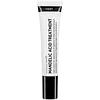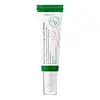What's inside
What's inside
 Key Ingredients
Key Ingredients

 Benefits
Benefits

 Concerns
Concerns

No concerns
 Ingredients Side-by-side
Ingredients Side-by-side

Water
Skin ConditioningPropanediol
SolventMandelic Acid
AntimicrobialCoco-Caprylate/Caprate
EmollientCetearyl Alcohol
EmollientGlycerin
HumectantSodium Hydroxide
BufferingCaprylic/Capric Triglyceride
MaskingGlyceryl Stearate
EmollientCandelilla/Jojoba/Rice Bran Polyglyceryl-3 Esters
EmulsifyingSodium Stearoyl Glutamate
CleansingPhenoxyethanol
PreservativeSodium Stearoyl Lactylate
EmulsifyingBenzyl Alcohol
PerfumingAcrylates/C10-30 Alkyl Acrylate Crosspolymer
Emulsion StabilisingCopernicia Cerifera Cera
EmollientRetinol
Skin ConditioningPolysorbate 20
EmulsifyingEthylhexylglycerin
Skin ConditioningDehydroacetic Acid
PreservativeHelianthus Annuus Seed Oil
EmollientTrisodium Ethylenediamine Disuccinate
Ceramide AP
Skin Conditioning1,2-Hexanediol
Skin ConditioningCaprylyl Glycol
EmollientDisodium Cocoamphodiacetate
CleansingTocopherol
AntioxidantXanthan Gum
EmulsifyingEthyl Ferulate
AntioxidantHumulus Lupulus Extract
AntimicrobialWater, Propanediol, Mandelic Acid, Coco-Caprylate/Caprate, Cetearyl Alcohol, Glycerin, Sodium Hydroxide, Caprylic/Capric Triglyceride, Glyceryl Stearate, Candelilla/Jojoba/Rice Bran Polyglyceryl-3 Esters, Sodium Stearoyl Glutamate, Phenoxyethanol, Sodium Stearoyl Lactylate, Benzyl Alcohol, Acrylates/C10-30 Alkyl Acrylate Crosspolymer, Copernicia Cerifera Cera, Retinol, Polysorbate 20, Ethylhexylglycerin, Dehydroacetic Acid, Helianthus Annuus Seed Oil, Trisodium Ethylenediamine Disuccinate, Ceramide AP, 1,2-Hexanediol, Caprylyl Glycol, Disodium Cocoamphodiacetate, Tocopherol, Xanthan Gum, Ethyl Ferulate, Humulus Lupulus Extract
Water
Skin ConditioningGlycerin
HumectantNiacinamide
SmoothingSodium Hyaluronate
HumectantPropanediol
SolventErythritol
HumectantButylene Glycol
HumectantSqualane
EmollientOryza Sativa Bran Extract
Skin ConditioningCalendula Officinalis Flower Extract
MaskingCarica Papaya Fruit Extract
Skin ConditioningHippophae Rhamnoides Fruit Extract
Skin ConditioningMalpighia Glabra Fruit Extract
Skin ConditioningPolyglyceryl-10 Laurate
Skin ConditioningChlorphenesin
AntimicrobialArginine
MaskingEthylhexylglycerin
Skin ConditioningCarbomer
Emulsion StabilisingGlutathione
1,2-Hexanediol
Skin ConditioningHydroxypropyl Cyclodextrin
MaskingDisodium EDTA
Hydroxyethylcellulose
Emulsion StabilisingAllantoin
Skin ConditioningRosmarinus Officinalis Leaf Oil
MaskingWater, Glycerin, Niacinamide, Sodium Hyaluronate, Propanediol, Erythritol, Butylene Glycol, Squalane, Oryza Sativa Bran Extract, Calendula Officinalis Flower Extract, Carica Papaya Fruit Extract, Hippophae Rhamnoides Fruit Extract, Malpighia Glabra Fruit Extract, Polyglyceryl-10 Laurate, Chlorphenesin, Arginine, Ethylhexylglycerin, Carbomer, Glutathione, 1,2-Hexanediol, Hydroxypropyl Cyclodextrin, Disodium EDTA, Hydroxyethylcellulose, Allantoin, Rosmarinus Officinalis Leaf Oil
 Reviews
Reviews

Ingredients Explained
These ingredients are found in both products.
Ingredients higher up in an ingredient list are typically present in a larger amount.
1,2-Hexanediol is a synthetic liquid and another multi-functional powerhouse.
It is a:
- Humectant, drawing moisture into the skin
- Emollient, helping to soften skin
- Solvent, dispersing and stabilizing formulas
- Preservative booster, enhancing the antimicrobial activity of other preservatives
Ethylhexylglycerin (we can't pronounce this either) is commonly used as a preservative and skin softener. It is derived from glyceryl.
You might see Ethylhexylglycerin often paired with other preservatives such as phenoxyethanol. Ethylhexylglycerin has been found to increase the effectiveness of these other preservatives.
Glycerin is already naturally found in your skin. It helps moisturize and protect your skin.
A study from 2016 found glycerin to be more effective as a humectant than AHAs and hyaluronic acid.
As a humectant, it helps the skin stay hydrated by pulling moisture to your skin. The low molecular weight of glycerin allows it to pull moisture into the deeper layers of your skin.
Hydrated skin improves your skin barrier; Your skin barrier helps protect against irritants and bacteria.
Glycerin has also been found to have antimicrobial and antiviral properties. Due to these properties, glycerin is often used in wound and burn treatments.
In cosmetics, glycerin is usually derived from plants such as soybean or palm. However, it can also be sourced from animals, such as tallow or animal fat.
This ingredient is organic, colorless, odorless, and non-toxic.
Glycerin is the name for this ingredient in American English. British English uses Glycerol/Glycerine.
Learn more about GlycerinPropanediol is an all-star ingredient. It softens, hydrates, and smooths the skin.
It’s often used to:
Propanediol is not likely to cause sensitivity and considered safe to use. It is derived from corn or petroleum with a clear color and no scent.
Learn more about PropanediolWater. It's the most common cosmetic ingredient of all. You'll usually see it at the top of ingredient lists, meaning that it makes up the largest part of the product.
So why is it so popular? Water most often acts as a solvent - this means that it helps dissolve other ingredients into the formulation.
You'll also recognize water as that liquid we all need to stay alive. If you see this, drink a glass of water. Stay hydrated!
Learn more about Water